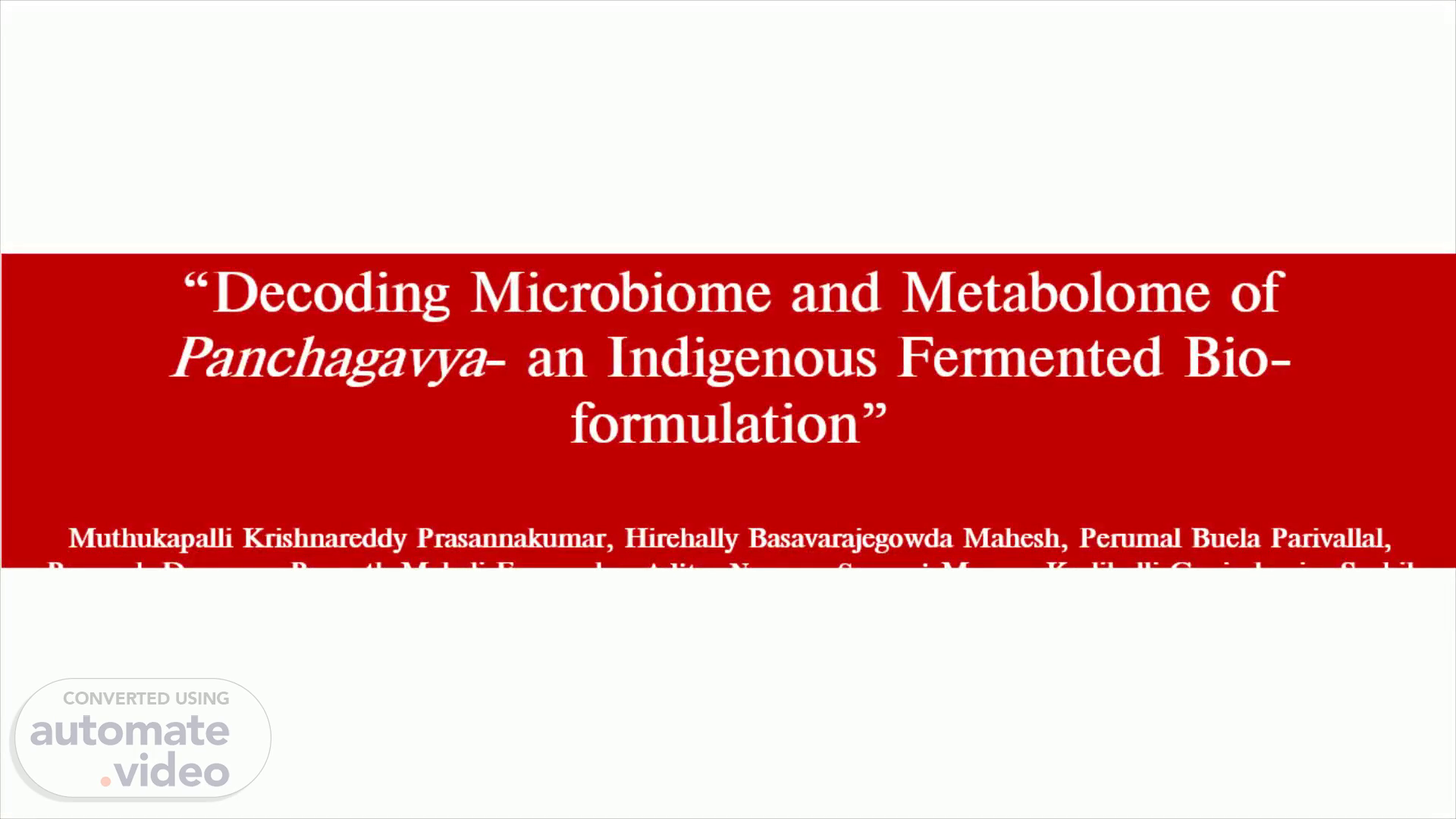
Page 1 (0s)
[Audio] Welcome, my name is Dr M K Prasanna Kumar, Professor at Department of Plant Pathology, University of Agricultural Sciences, GKVK, Bangalore, INDIA. Today, I'm happy to present our work titled " Decoding microbiome and metabolome of Panchagavya- an indigenous fermented bio-formulation" contributed by our team..
Page 2 (23s)
[Audio] The word ' Panchagavya' is derived from Sanskrit, meaning " five ingredients from a cow," which includes dung, milk, urine, curd, and clarified butter known as ghee. It has been reported that the application of 'Panchagavya' enhances plant growth, nutrient uptake, reduces the biotic and abiotic stresses in crop plants..
Page 3 (47s)
[Audio] The Panchagavya is prepared using 7 kg of fresh cow dung, 7 liters of cow's urine and 10 liters of water which was added and left in a tank and the mixture was stirred thoroughly everyday. On 16th day, 1 kg of fresh cow dung was added. Then 2 liters of milk, 2 liters of sour curd and 1 liter of ghee were added to the above mixture. The stirring process was continued for 7 days more. On the 18th day, Panchagavya solution was ready for use. Cow dung acts as a medium for the growth for the beneficial microbes. Cow's urine provides nitrogen which is essential for crop growth. Milk provides protein, fat, carbohydrates, amino acids and calcium. Curd provides lactobacillus which acts as a catalyst in the digestion of organic wastes. Ghee provides vitamin A and B, calcium and fat..
Page 4 (1m 50s)
[Audio] With the recent advancement in metagenomic sequencing, constructing the whole microbiome is easier and more comprehensive than the 16S rRNA sequencing of only culturable bacteria. However, metagenomics reveals only the microbial populations; therefore, metabolomics is required to study the in situ microbial metabolic activity and their capabilities. Therefore, with the aid of metabolomics, we can identify the plant growth-promoting compounds, including hormones, which can be further screened with high-throughput metabolite identification technologies such as Liquid Chromatography Mass Spectrometry. In this study, we report an integrated approach to connect the microbial population assemblages of the Panchagavya by metagenomics and identifying its potential plant-growth-promoting molecules through LCMS attached to the metlin library. Furthermore, by combining different omics technologies, we have revealed the overall function of these microbes in Panchagavya..
Page 5 (2m 53s)
[Audio] The metagenome sequencing approach was used in this study to understand the diversity and function of microbial niches, which could not be addressed using conventional methods. We have employed a Metagenomic sequencing approach for profiling all the associated microbiota of Panchagavya. The analysis revealed that Panchagavya harbours a wide range of bacterial genera. Further, functional classification of identified bacterial genera revealed the abundance of bacteria involved in PGPR, ISR, biocontrol of plant pathogens, nutrient recycling in soil, and production of plant hormones..
Page 6 (3m 34s)
[Audio] The operational taxonomic unit ( OTU) picking through ' Eukaryotic and prokaryotic diversity was estimated using CCMetagen v1. 2. 5' which revealed that the domain bacteria were the most abundant OTUs ( 99.58%) with a high abundance of species belonging to the phylum Proteobacteria ( 40.40%), Firmicutes ( 26.90%), and Bacteroidetes ( 14.20%). The relative distribution of bacteria belonging to the different phylum, class, order, family and genus are summarized in this figure..
Page 7 (4m 12s)
[Audio] Here is a representation of taxonomic identity and their abundance of different bacteria identified in the Panchagavya bio-formulation..
Page 8 (4m 45s)
[Audio] Here is a representation of functional annotations of gene through gene ontology plot and pie chare representing functional annotation of the predicted protein into major functions..
Page 9 (5m 6s)
[Audio] Microbial community composition of Panchagavya formulation assessment using CCMetagen revealed 18 % of the reads are of eukaryotic origin.
Page 10 (5m 17s)
[Audio] The Extraction of metabolites for LC-MS/ MS analysis was done using Multi-solvent and aqueous followed by LC-MS/MS analysis using QTRAP 6500 mass spectrometer Agilent 1290 Infinity II LC system and finally the analysis of metabolome data using XCMS online tool Metlin metabolite database..
Page 11 (5m 43s)
[Audio] The XCMS was used to decipher the metabolites of the Panchagavya formulation. A total of 5737 features were identified in XCMS metabolite analysis of which 2970 were identified in the Metlin database..
Page 12 (6m 2s)
[Audio] The essential plant hormones, like gibberellic acid and its eight other derivatives such as Gibberellin A70, Gibberellin A45, Gibberellin A61, Gibberellin A51, Gibberellin A4, Gibberellin A20, Gibberellin A29-catabolite, and Gibberellin A14 aldehyde were recorded..
Page 13 (7m 9s)
[Audio] Panchagavya helps in the production of synthetic pesticide-free food. Its is an organic product which can be used as a manure. It enhances the plant grown and its immunity. It also helps in improving soil fertility and maintaining good soil health..
Page 14 (7m 29s)
[Audio] For the first time, updated molecular techniques were used to validate and elucidate the effect of Panchagavya. Metagenomics was used to decipher the bacterial microbiome structure, which showed promising results for their existence and abundance in Panchagavya. The metabolome predicted the byproducts of numerous plant growth promoters as well as other compounds released and fermented by these bacteria. According to these findings, Panchagavya is a promising manure that contains helpful microorganisms and plant development promoters. As a result, Panchagavya is a bio-formulation that is both ecologically benign and effective in improving soil and crop health..